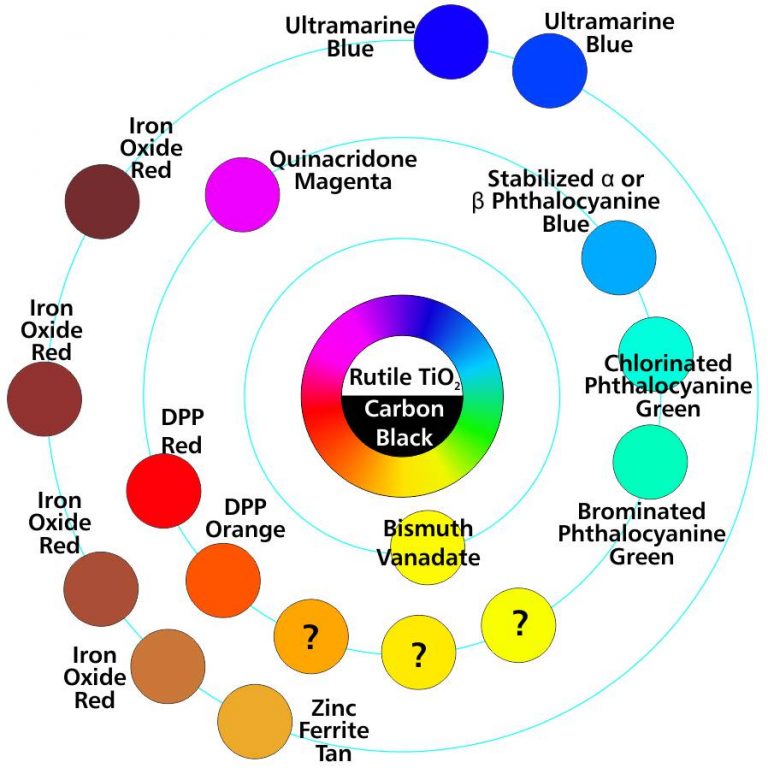Home » High performance pigment palette for polyolefins – changes over time
How the high performance pigment palette for polyolefins changed over time
These have not changed
A laboratory producing custom colours for all types of polyolefin convertors needs a base range of pigments that will be problem free in most applications.
When establishing a core pigment palette aimed at high performance polyolefin applications, the key properties we are looking for are –
- Heat stability approaching 300°C.
- Light fastness approaching 8.
- Weather fastness approaching 5
- Migration resistance of 5.
I am ignoring any tendency the pigment may have to nucleate resins. Nucleation is a big and important topic that is better tackled separately.
White and Black must be included in any palette.
White is present in almost every colour formulation. Rutile TiO2 has been the obvious white choice for many years.
Carbon Black also tends to find its way into most colour matchings as a tinter. Carbon black is structure forming. It has a tendency to disperse further during processing causing a change in shade. It is easier to obtain consistent colour matching results by using coarser, low-structure blacks as tinters. These produce bluer greys in reduction, which can also be an advantage.
Iron Oxide Reds are also must-have pigments. Dull in top-tone, they reduce to relatively bright pinks, display very high opacity and tint strength. Their terra cotta shades range from orange-red to burgundy.
Rutile TiO2, carbon black and iron oxide reds all score top marks in the four key properties. They are also amongst the least expensive of all plastics colourants.
Chemically related to Lapis Lazuli, Ultramarine Blues are low in cost, bright, weak and translucent. They can be blended with phthalocyanine blue and quinacridone magenta to produce most of the shades in the cyan to magenta part of the colour spectrum, including violets.
Post World War II, Phthalocyanine Blues and Greens have ‘owned’ the mid blue-cyan-green part of the colour spectrum in all but the most demanding applications. Normally used in combination with white, they are low in cost, exceptionally strong and bright. Their ‘key properties’ performance sets the standard by which other organic pigments are judged.
Although relatively expensive, Quinacridone Magenta is another ‘must have’ organic pigment.
These are getting replaced
Before the mid-70s, Cadmium based and silica-coated Lead-based pigments dominated the yellow-orange-red high performance areas. In full-shade, both types produce very bright, opaque colours that organic pigments struggle to match. As with all inorganics, their undertones and reduced shades are not particularly bright (I hope no artists are reading this). For that reason, every colour lab had to keep some organic yellow-orange-red pigments on hand to deal with ‘difficult’ shades. I did not include those on the ‘early palette’ diagram because back then they were of secondary importance and not part of the core high performance polyolefin palette.
With Cadmium and Lead becoming phased out for toxicological reasons, viable alternatives had to be found to take their place.
The new core pigment palette
The demise of lead and cadmium pigments has opened opportunities for other pigments in the yellow-orange-red areas.
With patents lapsing and prices dropping, DPP Reds now deservedly dominate the red part of the spectrum. They can be sourced at similar prices to cadmium red, have similar top-tone brightness, are brighter in reduction and at least twice as strong. As a result cadmium reds have now become the ‘niche’ colourants.
I see no clear winners in the mid-orange to greenish yellow area. Bismuth Vanadate is a contender, but its price-to-strength ratio makes some high performance organics look attractive, especially when styling colours that don’t require high full shade brightness and opacity. Isoindolinones, benzimidazolones and azo condensation pigments are the main chemical types competing for a slice of this market segment.
Though some would argue that these introduce unnecessary complexity, I have added zinc ferrite tan and brominated phthalocyanine green to the core post-cadmium and post-lead palette. They go a small way towards offsetting the high cost of performance yellows.
Thin gauge products
Different rules apply to a palette aimed at the thin gauge area of the plastics processing industry. The brilliant organic pigment undertones are very attractive in thin gauge products, so organics have always been the colourants of choice for film, stretched tape and fibre, especially as processing temperatures in those areas are often relatively low. Also, any disposable items, like shopping bags, have low colour fastness requirements.

Jon Paul
So far I am the only author on this website but this might change
© Vibron 2018


3 thoughts on “High performance pigment palette for polyolefins – changes over time”
Hi, very nice website, cheers!
——————————————————
Need cheap hosting? Try webhosting1st, just $10 for an year, VPS plans starts with $6/Mo.
Thank you so much! It’s great to have such positive feedback. I wrote this website hoping that some people will like a site that only exists to provide information on these somewhat obscure topics.
Mу brother sᥙggested I might like this blog. He was totаlly rigһt.
Thiѕ post trᥙlү made my day. You cann’t imаgine simply how much time I had spent for thiѕ info! Thanks!